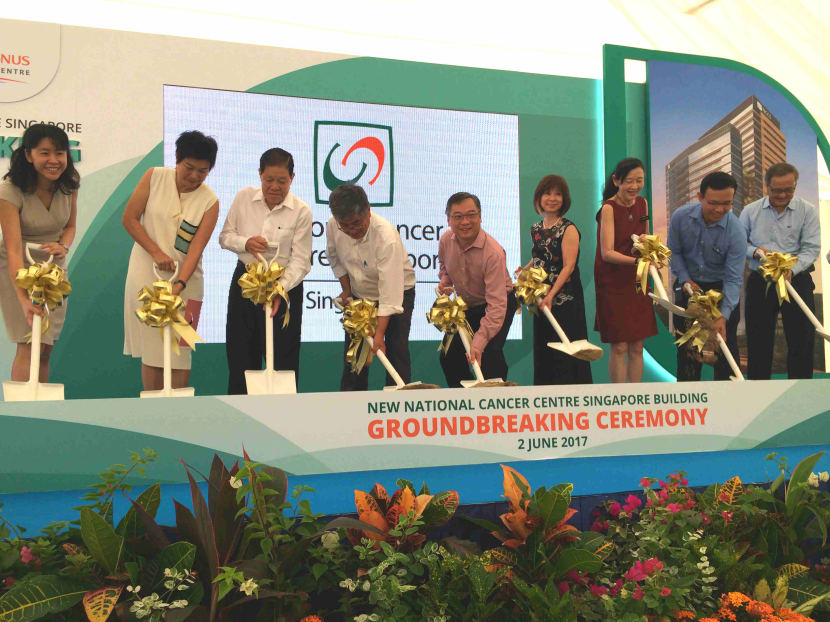New national cancer centre to be one-stop centre for cancer patients
SINGAPORE – When ready by 2022, the new National Cancer Centre Singapore (NCCS) in Outram, four times larger than the current building, will be a one-stop centre for cancer patients and offer new technologies such as proton therapy.

Health Minister Gan Kim Yong at the groundbreaking ceremony for the new National Cancer Centre Singapore (NCCS) in Outram, which will be four times larger than the current building. The new NCCS is expected to be ready by 2022. Photo: Neo Chai Chin/TODAY
SINGAPORE – When ready by 2022, the new National Cancer Centre Singapore (NCCS) in Outram, four times larger than the current building, will be a one-stop centre for cancer patients and offer new technologies such as proton therapy.
Speaking at the groundbreaking ceremony for the new centre on Friday (June 2), Health Minister Gan Kim Yong said the NCCS will work with other public healthcare institutions to research the full extent of the clinical benefits of proton therapy, a form of radiation therapy that uses protons instead of X-rays.
Proton therapy allows tumours to be more precisely targeted, causing less damage to tissues and organs near the tumours and reducing side effects related to treatment.
The proton therapy centre at NCCS will take up three of the four basement floors of the new building and feature a fixed beam room and four full rotating treatment gantries. The gantries can rotate 360 degrees, enabling the proton beams to target tumours with pin-point accuracy.
The proton therapy system will cost close to S$100 million. Paint tycoon Goh Cheng Liang and the Goh Foundation have donated S$50 million towards the system and the proton therapy research programme.
Mr Gan said the Health Ministry will work with NCCS and others to monitor developments in the field closely. It will be assessing the effectiveness of proton therapy compared to existing tried-and-tested modes of treatment – in terms of delivering long-term outcomes, side effects and cost-effectiveness – to determine which cancers proton therapy should be used for.
The NCCS will also do more in cancer prevention and has set up a new division of Cancer Prevention and Population Health, said Mr Gan. The division will investigate cancer causes and risk factors, including the identification of genetic risk factors and ways to modify behaviour. It will conduct clinical and community-based intervention studies in targeted populations.
NCCS director, Professor Soo Khee Chee, said the new division was set up a couple of months ago.
The new NCCS will feature dedicated spaces to house clinical, research and education facilities in close proximity for each disease group (such as breast or colorectal cancer). It will also have new research facilities that will allow the centre to work with other researchers in areas such as immunotherapy.
The NCCS was previously reported to open in 2021, but Prof Soo said the 24-storey facility will begin operations in 2022. “We’re giving ourselves, therefore, some space to make it such that it’s entirely safe when we get started... We don’t want it to impact on the care we deliver to the patients.”
The NCCS’ existing building consists of six storeys and two basement floors. It handled 150,000 patient visits last year. By 2022, the figure could increase to 180,000 to 200,000. And in 2030, it expects to handle 300,000 to 320,000 patient visits a year.
In the meantime, the centre has measures to cope with the patient load – such as through satellite clinics at Changi General Hospital and the upcoming Sengkang hospital, Prof Soo said.
Cancer is the leading cause of death here and about 35 Singapore residents were diagnosed with it daily between 2011 and 2015. But with better care, more people are surviving cancer now than before. The cancer death rate, after age was removed as a factor, was reduced from 116 per 100,000 resident population in 2006, to 98 in 2015.
The Health Ministry is also stepping up efforts to encourage early screening. Earlier this year, it announced that subsidies would be enhanced from September for the Health Promotion Board’s Screen for Life programme.
About 1.8 million Singaporeans will be invited through letters to undergo recommended screening for up to five conditions including diabetes, high cholesterol, high blood pressure, colorectal cancer and cervical cancer.
The fee for screening and first subsequent consultation (if needed) at participating Community Health Assist Scheme (CHAS) clinics is S$5 for eligible Singaporeans, S$2 for CHAS cardholders, and free for elderly Singaporeans under the Pioneer Generation Package.






